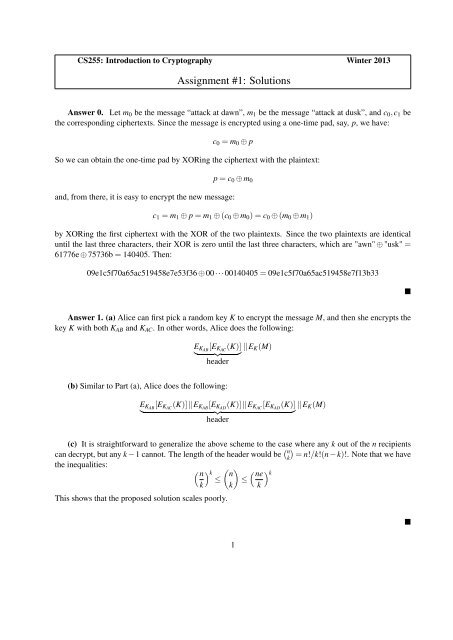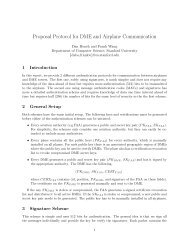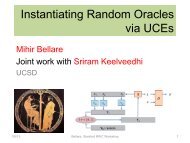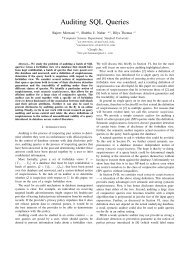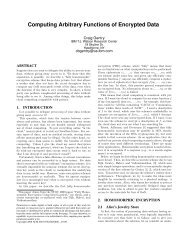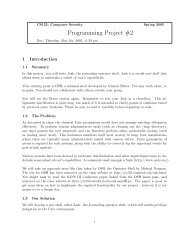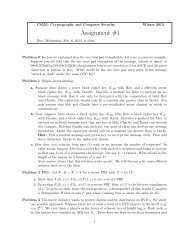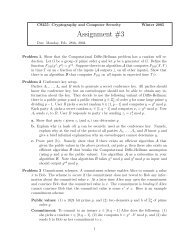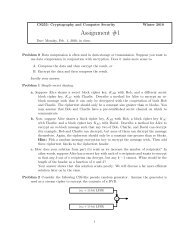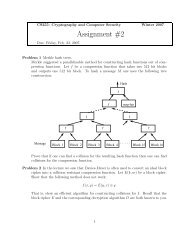Assignment #1: Solutions - Stanford Crypto Group
Assignment #1: Solutions - Stanford Crypto Group
Assignment #1: Solutions - Stanford Crypto Group
You also want an ePaper? Increase the reach of your titles
YUMPU automatically turns print PDFs into web optimized ePapers that Google loves.
CS255: Introduction to <strong>Crypto</strong>graphy Winter 2013<br />
<strong>Assignment</strong> <strong>#1</strong>: <strong>Solutions</strong><br />
Answer 0. Let m0 be the message “attack at dawn”, m1 be the message “attack at dusk”, and c0,c1 be<br />
the corresponding ciphertexts. Since the message is encrypted using a one-time pad, say, p, we have:<br />
c0 = m0 ⊕ p<br />
So we can obtain the one-time pad by XORing the ciphertext with the plaintext:<br />
p = c0 ⊕ m0<br />
and, from there, it is easy to encrypt the new message:<br />
c1 = m1 ⊕ p = m1 ⊕ (c0 ⊕ m0) = c0 ⊕ (m0 ⊕ m1)<br />
by XORing the first ciphertext with the XOR of the two plaintexts. Since the two plaintexts are identical<br />
until the last three characters, their XOR is zero until the last three characters, which are "awn" ⊕ "usk" =<br />
61776e ⊕ 75736b = 140405. Then:<br />
09e1c5f70a65ac519458e7e53f36 ⊕ 00···00140405 = 09e1c5f70a65ac519458e7f13b33<br />
Answer 1. (a) Alice can first pick a random key K to encrypt the message M, and then she encrypts the<br />
key K with both KAB and KAC. In other words, Alice does the following:<br />
EKAB<br />
[EKAC (K)]<br />
<br />
header<br />
(b) Similar to Part (a), Alice does the following:<br />
EK(M)<br />
EKAB<br />
[EKAC (K)]EKAB [EKAD (K)]EKAC [EKAD (K)] EK(M)<br />
<br />
header<br />
(c) It is straightforward to generalize the above scheme to the case where any k out of the n recipients<br />
can decrypt, but any k −1 cannot. The length of the header would be n<br />
k = n!/k!(n−k)!. Note that we have<br />
the inequalities:<br />
<br />
n<br />
<br />
k n<br />
<br />
ne<br />
k ≤ ≤<br />
k k k<br />
This shows that the proposed solution scales poorly.<br />
1
Answer 2. (a) Consider an adversary that makes a single query to the challenger at the point 0, obtaining<br />
some string y, and outputs 1 if the first bit of y equals the (|y|/2 + 1) th bit of y, and outputs 0 otherwise.<br />
Now, in the real world, the adversary receives y = F1(k,0) = F(k,0)||F(k,0), and so the two selected bits will<br />
always match, and the adversary will always output 1. In the ideal world, the adversary receives y = R(0), a<br />
uniformly random string, and the two selected bits will match with probability 1/2. Thus, the adversary has<br />
advantage |1 − 1/2| = 1/2, which is nonnegligible.<br />
(b) Suppose there is an adversary A that breaks F2. We will construct an adversary B to break F. Our<br />
adversary B runs A internally, and for each of its queries x, submits x ⊕ 1 n to the challenger, and returns the<br />
result to A. When A terminates, B then outputs whatever bit A outputs. Now, when B faces the real-world<br />
challenger, A sees F(k,x⊕1 n ) = F2(k,x); while when B faces the ideal-world challenger, A still sees a fresh<br />
uniformly random string for each distinct query, matching its view in the PRF security game for F2. Thus<br />
A, and hence B, must have nonnegligible advantage in distinguishing the two worlds, a contradiction since<br />
F is assumed to be a secure PRF.<br />
Answer 3. (a) Let nodes v1,...,vlog 2 n be the nodes along the path from the root of the tree to leaf<br />
node number r. Since the tree is binary every node vi for i = 2,...,log 2 n has exactly one sibling. Let<br />
u2,u3,...,ulog 2 n be the siblings of nodes v2,...,vlog 2 n. Let K2,...,Klog 2 n be the AES keys associated with<br />
the nodes u2,...,ulog 2 n. The header will contain the encryption of the content-key K under all keys K =<br />
{K2,...,Klog 2 n}. Clearly player number r cannot decrypt the movie since it does not have any of the keys<br />
in K. However, any other player t = r can decrypt the movie. To see this, consider the path from the root<br />
of the binary tree to leaf node t. Let u be the highest node along this path that does not appear on the path<br />
from the root to leaf node r. Then the key Ku associated with node u is in the set K (since the sibling of u is<br />
a on the path to r). Furthermore, player t contains the key Ku and it can therefore obtain the content-key and<br />
then the movie. Hence, player r cannot play the movie, but all other players can.<br />
(b) For i = 1,...,k let Ui be the set of consecutive leaves in the range [ri + 1,ri+1 − 1] (we are assuming<br />
r0 = 0 and rk+1 = n + 1). For an internal node v in the binary tree let Sv be the set of leaves in the subtree<br />
rooted at v. We say that a set of leaves Ui is exactly covered by internal nodes v1,...,vb if Ui = ∪b j=1Sv j . We<br />
show below that each set Ui can be exactly covered by a set of at most 2 · log2 n internal nodes. This means<br />
that to exactly cover all sets U0,...,Ur we need at most c = 2(r + 1)log2 n internal nodes. Let v1,...,vc<br />
be the internal nodes needed to cover all of U0,...,Ur. If we encrypt the content-key using the keys Kv<br />
associated with each of these nodes then all players other than those in R can recover the content-key while<br />
the players in R cannot. This shows that using header containing at most 2(r + 1)log2 n ciphertexts we can<br />
revoke all players in R without affective any of the other players.<br />
It remains to show that given a set of consecutive leaves U in some range [a,b] it is possible to exactly<br />
cover U using at most 2 · log2 n internal nodes. Let u1 be the highest node in the tree so that the subtree<br />
rooted at u1 has leaf a as its left most leaf. Let v1 be the highest node in the tree so that the subtree rooted at<br />
v1 has leaf b as its right most leaf. Now, for i = 2,...,log2 n define ui to be the right sibling of the parent of<br />
ui−1 (the right sibling of a node w is the node at the same height as w which is immediately on the right of<br />
w). Similarly, define vi to be the left sibling of the parent of vi−1. Let j be the smallest value so that u j = v j<br />
or that u j,vj are adjacent siblings in the tree. Then it is easy to see that u1,...,uj,vj,...,v1 is an exact cover<br />
of [a,b]. This covering set contains at most 2 · log2 n nodes as required.<br />
2
Answer 4. (a) For every i ∈ {1,...,32}, a particular player ℓ has either key ki,0 or key ki,1, depending<br />
on bi—the i-th bit in the binary representation of ℓ. Given a ciphertext (i,c0,c1), player ℓ can obtain the<br />
message m by decrypting cbi .<br />
(b) Assume that the pirate decoder has the key Kj embedded. Suppose we feed the ciphertext Ci =<br />
( i, E(ki,0,m0), E(ki,1,m1) ) into the player, with m0 and m1 corresponding to observably different content.<br />
If the player plays content m0 (resp. m1) then it must possess the key ki,0 (resp. ki,1). Hence, by observing<br />
the result, we learn the i-th bit of index j. By feeding n different ciphertexts, we can retrieve the complete<br />
index j bit by bit.<br />
(c) Let in−1in−2 ...i0 and jn−1 jn−2 ... j0 be the binary representations of i and j respectively. Let a be an<br />
index where the two binary representation differ—i.e. a ∈ {0,1,...,n − 1} such that ia = ja. We build the<br />
pirate player P by replacing the a-th key in player i with the a-th key from player j. In other words, player<br />
P has the following key embedded:<br />
KP = k0,i0 ,k1,i1 ,...,k (a−1),ia−1 ,ka, ja ,k (a+1),ia+1 ,...,k <br />
(n−1),in−1<br />
Tracing algorithm from part (b) produces the index ℓ = in−1 ...ia+1 jaia−1 ...i0. Since ia = ja index ℓ is<br />
obviously different from i; since i ⊕ j is not a power of 2, index ℓ has to be different from j as well.<br />
Answer 5. (a) A simple way to construct an efficient adversary is as follows: Send the packet containing<br />
all 0s to the server to be encrypted. Since we are playing the CPA security game, the server will then send<br />
us the encryption of this packet, which we call c0. This packet will contain exactly the encryption of 0 ⊕ IV,<br />
where IV is the initialization vector chosen by the encryption system. Next, suppose we take the last block<br />
of c0 and XOR it with the all zeroes block to get p1. Sending across p1 to the server to be encrypted results<br />
in the following: E(p1) = E(c ′ 0 ⊕ c′ 0 ⊕ 0) = E(0), where c′ 0 refers to the last block of c0. This means our<br />
output is just the encryption of 0 and therefore, our next IV is 0.<br />
In the next phase of the game, we use two challenge plaintexts: the all zeroes plaintext referred to as m0<br />
and a randomly chosen string m1 = m0. Note that the encryption of m0 is E(0), which is already known. The<br />
encryption of m1 will be, with sufficiently high probability, something else. If the challenge string returned<br />
is equal to E(0), then we output the bit 0, i.e., guess that the original plaintext was m0. Otherwise, we guess<br />
1. We win the CPA game with probability very close to 1. This attack works with any fixed input that will<br />
constitute m0. We do not necessarily require the all zeroes string.<br />
(b) Re-encrypt the last block of the packet (with a new key derived from the original key in a secure<br />
manner) before using it as the IV. In order to predict the IV, the adversary would have to be able to guess the<br />
encryption of the ciphertext (which is distributed approximately uniformly at random) under some unknown<br />
key with a non-trivial success probability. An adversary that could do this would break the semantic security<br />
of AES, so we assume the method works.<br />
(c) Our CPA adversary A interacts with the challenger as follows. Send the query q ∗ = 0 n , the all-zeroes<br />
string. A receives C ∗ = ECBC(k,0 n ) that includes the IV chosen (let’s call it IV ∗ ) and the encrypted message<br />
block. For the semantic security challenge, A chooses M0 = 0 n and M1 = 1 n (or equivalently any other<br />
message). It receives Cb and must guess b. If Cb = C ∗ , output 0, else output 1.<br />
3
To analyze the advantage of A, in Exp0, if the IV chosen matches IV ∗ (which happens with probability<br />
1<br />
2n ), then A output 0. In all other cases, it outputs 1. Thus Pr[A(Exp0) = 1] = 1 − 1<br />
2n . In Exp1, A never<br />
outputs 0, thus Pr[A(Exp1) = 1] = 1. The advantage is: |Pr[A(Exp0) = 1] − Pr[A(Exp1) = 1]| = 1<br />
2n as<br />
required.<br />
Answer 6. (a) In CBC mode, decryption is as follows:<br />
Pi = DK(Ci) ⊕Ci−1, C0 = IV.<br />
Blocks ℓ/2 and ℓ/2+1 will be affected by a corrupted aiphertext C ℓ/2. Therefore, 2 blocks will be decrypted<br />
incorrectly.<br />
(b) In randomized counter mode decryption, we regenerate the keystream using the randomized counter<br />
and incrementing it for every subsequent block. Therefore, only block ℓ/2 will be decrypted incorrectly.<br />
4


